Collection: Jesus Christ: Pantocrator
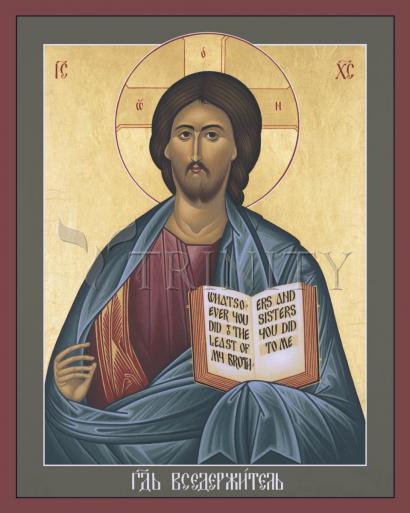
-
Sale
Wood Plaque Premium
Regular price From $99.95 USDRegular priceUnit price per$111.06 USDSale price From $99.95 USDSale -
Sale
Wood Plaque
Regular price From $34.95 USDRegular priceUnit price per$38.83 USDSale price From $34.95 USDSale -
Sale
Wall Frame Espresso
Regular price From $109.95 USDRegular priceUnit price per$122.17 USDSale price From $109.95 USDSale -
Sale
Wall Frame Gold
Regular price From $109.95 USDRegular priceUnit price per$122.17 USDSale price From $109.95 USDSale -
Sale
Wall Frame Black
Regular price From $109.95 USDRegular priceUnit price per$122.17 USDSale price From $109.95 USDSale -
Sale
Canvas Print
Regular price From $84.95 USDRegular priceUnit price per$94.39 USDSale price From $84.95 USDSale -
Sale
Metal Print
Regular price From $94.95 USDRegular priceUnit price per$105.50 USDSale price From $94.95 USDSale -
Sale
Acrylic Print
Regular price From $94.95 USDRegular priceUnit price per$105.50 USDSale price From $94.95 USDSale -
Sale
Giclée Print
Regular price From $19.95 USDRegular priceUnit price per$22.17 USDSale price From $19.95 USDSale -
Custom Text Note Card
Regular price From $300.00 USDRegular priceUnit price per$333.33 USDSale price From $300.00 USDSale
ARTIST: Br. Robert Lentz, OFM
ARTWORK NARRATIVE:
The Greek word Pantocrator means "Ruler of All." This icon depicts the divine majesty of the Creator under the human features of the Incarnate Son. Christ’s Gospel is opened to the twenty-fifth chapter of St. Matthew, the account of the Last Judgment. Here Christ identifies himself with the poor and oppressed. The splendor of God’s majesty and the mud and dust of the world’s slums are thus brought together, and the church is reminded that her only legitimate tie on earth is to the poor and marginalized.
The inscription in the upper corners of the icon are the Greek abbreviations for Jesus Christ. The Greek letters in the cross in Christ’s halo are the divine name revealed to Moses in the burning bush, "I am who am." The inscription at the bottom is Slavonic for "Pantocrator." The gold background represents the uncreated light that surrounds God in Glory.
- Art Collection:
-
Christ Images
- Lentz collection:
-
Images of Christ
When the Son of Man comes in his glory, and all the angels with him, he will sit upon his glorious throne, and all nations will be assembled before him. And he will separate them one from another, as a shepherd separates the sheep from the goats. He will place the sheep on his right and the goats on his left. Then the king will say to those on his right, “Come, you who are blessed by my Father. Inherit the kingdom prepared for you from the foundation of the world. For I was hungry and you gave me food, I was thirsty and you gave me drink, a stranger and you welcomed me, naked and you clothed me, ill and you cared for me, in prison and you visited me." Then the righteous will answer him and say, “Lord, when did we see you hungry and feed you, or thirsty and give you drink? When did we see you a stranger and welcome you, or naked and clothe you? When did we see you ill or in prison and visit you?" And the king will say to them in reply, “Amen, I say to you, whatever you did for one of these least brothers of mine, you did for me."
Matthew 25:31-40
The Origins of This Image
The word Pantocrator is Greek, meaning "Ruler of All." The image expresses the central reality of the Christian faith; the Divine Majesty of the creator and ruler of all the world, made flesh and therefore visible to us in the person of Christ Jesus our redeemer. The oldest known icon of Christ Pantocrator was written in the sixth century and preserved in the remote monastery of St. Catherine in the Sinai desert. The location enabled the image to survive the destruction of most icons during the iconoclastic era in Byzantine history. (726 to 815 AD)
On the inside of the central dome in Orthodox churches is frequently found an immense mosaic or painting of Christ Pantocrator. The Pantocrator image typically found in church domes is very stern and formidable, expressing in full the concept of "Ruler of All." Smaller, personal icons, while retaining the same majesty, more often represent a gentle and compassionate Lord.
Theology and Symbolism
In this image of Christ Pantocrator, Jesus is presented in a half-length pose, looking directly at the viewer, with his left hand holding the Sacred Word and his right hand raised in blessing. He is dressed in the traditional garb of tunic and cloak. His cloak, called in Greek a "himation" is dark blue signifying the mystery of His divine life. His tunic is a bright crimson red to signify His human blood shed for us all. The garments of the Messiah in Isaiah 63:1-4 were red, as was the soldier's cloak put on Jesus' shoulders during his passion. (Matthew 27:28)
The Bible he holds in his left hand is open to display a passage from the Gospel. Various passages are used in Pantocrator icons as are various languages. The most common is Matthew 11:28, "Come to me all you that are weary..." Other verses used have been John 7:24, John 8:12, John 13:34, John 14:6, Matthew 11:27, and Matthew 25:34.
The arrangement of fingers on Jesus' right hand raised in blessing is significant. Two different forms may be seen in iconography. These two forms date from a schism that split the Russian Orthodox Church in 1667. Patriarch Nikon instituted reforms that a group of people who came to be known as the Old Believers refused to accept. This icon displays the Old Believer form: Thumb, ring finger and little finger are bent together symbolizing the divine and human natures of Christ, while the forefinger and slightly bent middle finger are held upright. The second, or State Church form spells out Iesous Khristos, the Greek shortened form of Christ's name, "IC XC." The index finger is straight, forming the "I," the middle and little fingers are curved into "C" shapes, and the thumb and ring finger cross slightly to form the "X."
Christ's halo, the iconographic symbol for sanctity, is inscribed with a cross and the Greek letters omicron, omega, nu, spelling "HO ON." In English, this becomes "Who Am," the name used for God in Exodus 3:14. On the background is written "IC XC."
The face of Jesus follows ancient traditions. The eyes are large and open, looking directly into the soul of the viewer. The forehead, identified as the seat of wisdom, is high and convex. The nose is long and slender, contributing a look of nobility. The mouth is small and closed in the silence of contemplation. The hair is curled and flowing, recalling the endless flow of time. The neck and body are powerful reminders of His strength and majesty.
Additional Items Our Customers Like
-
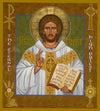
Jesus Christ - Eternal High Priest (by Joan Cole)
-

Jesus Christ: Liberator (by Br. Robert Lentz, OFM)
-
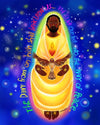
Jesus Dawn From On High (by Br. Mickey McGrath, OSFS)
-
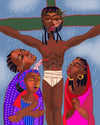
Jesus Dies on the Cross (by Br. Mickey McGrath, OSFS)
-
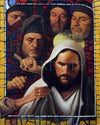
Jesus' Foes (by Louis Glanzman)
-
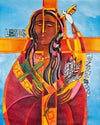
Jesus I Love You - Lesos Konoronhkwa (by Br. Mickey McGrath, OSFS)


















